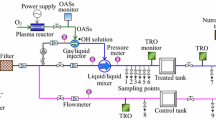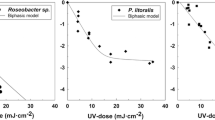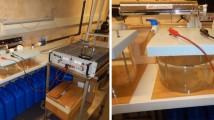Abstract
The viability of different species ofSalmonella in seawater was studied under controlled laboratory conditions. The negative influence of water self-purifying factors exerted on the survival of the microorganisms varied depending on the factor considered and also on the specie selected. Biotic and luminous factors were mainly responsible for the inactivation and disappearance ofSalmonella in the water solutions. The addition of 1% of sewage to filtered seawater and freshwater provoked a decrease in the number ofSalmonella populations tested in comparison with the solutions without sewage. On the other hand, an increase of sublethally injuredSalmonella cells with respect to exposure time was not observed. From the results obtained from T90 inactivation experiments, it may be deduced that the main factor implicated in the disappearance ofSalmonella from the water mass is physical dilution.
Similar content being viewed by others
Literature Cited
Anderson IC, Rhodes M, Kator H (1983) Seasonal variation in survival ofEscherichia coli exposed in situ in membrane diffusion chambers containing filtered and non-filtered estuarine water. Appl Environ Microbiol 45:1877–1883
Aubert M, Pesando D, Gauthier MJ (1975) Effects of antibiosis in a marine environment. In: Gameson A (ed) Discharge of sewage from sea outfalls. London: Pergamon Press, pp 191–197
Borrego JJ (1982) Estudio de los bacteriofagos deEscherichia coli en el agua de mar. Su relacion con la polucion de dicho medio. PhD thesis, Universidad de Málaga
Borrego JJ, Florido JA, Moriñigo MA, Martinez E, Romero P (1983) Decline ofEscherichia coli cells in different water types. Rapp Comm Int Mer Medit 28:25–26
Buck JC (1977)Candida albicans. In: Hoadley A, Dutka B (eds) Bacterial indicators/health hazards associated with water. Philadelphia: American Society for Testing and Materials, pp 139–147
Cabelli JJ, Kennedy H, Levin MA (1976)Pseudomonas aeruginosa-fecal coliform relationships in estuarine and fresh recreational waters. J Water Pollut Control Fed 48:367–381
Casida LE Jr (1980) Bacterial predators ofMicrococcus luteus in soil. Appl Environ Microbiol 39:1035–1041
Colwell RR (1978) Bacterial and viruses-indicator of environmental changes in estuaries. Environ Int 1:223–231
Colwell RR, Kaper JB (1981)Vibrio y Aeromonas. In: Dutka B (ed) Membrane filtration: applications, techniques and problems. New York: Marcel Dekker, Inc, pp 161–188
Cornax R (1986) Estudio de la supervivencia de microorganismos aloctonos en el medio ambiente marino. M S thesis. Universidad de Málaga.
Enzinger RM, Cooper RC (1976) Role of bacteria and protozoa in the removal ofEscherichia coli from estuarine waters. Appl Environ Microbiol 31:758–763
Evison LM, Tosti E (1980) An appraisal of bacterial indicators of pollution in sea water. Prog Wat Tech 12:591–599
Fattal B, Vasl RJ, Katzenelson E, Shuval HI (1983) Survival of bacterial indicator organisms and enteric viruses in the Mediterranean coastal waters off Tel-Aviv. Water Res 17:397–402
Fujioka RS, Narikawa OT (1982) Effect of sunlight on enumeration of indicator bacteria under field conditions. Appl Environ Microbiol 44:395–401
Gameson AL, Gould DJ (1975) Effects of solar radiation on the mortality of some terrestrial bacteria in seawater. In: Gameson A (ed) Discharge of sewage from sea outfalls. London: Pergamon Press, pp 209–219
Gauthier MJ (1980) Polucion en el medio marino. In: Peres J (ed) La polución de las aguas marinas. Barcelona: Omega S. A., pp 127–141
Geldreich EE (1978) Bacterial populations and indicator concepts in feces, sewage, stormwater and solid wastes: In: Berg G (ed) Indicators of viruses in water and food (Ann Arbor, Michigan: Ann Arbor Science, pp 51–97
Gerba CP, McLeod JS (1976) Effect of sediments on the survival ofEscherichia coli in marine waters. Appl Environ Microbio 32:114–120
Goyal SM, Gerba CP, Melnick JL (1977) Occurrence and distribution of bacterial indicators and pathogens in canal communities along the Texas Coast. Appl Environ Microbiol 34:139–149
Harmon SM, Kautter DA, Peeler JT (1971) Improved medium for enumeration ofClostridium perfringens. Appl Microbiol 22:688–692
Harvey RW, Price TH (1979) Principles ofSalmonella isolation. J Appl Bacteriol 46:27–56
Jones GE, Cobet AB (1975) Heavy metal ions as the principal bactericidal agent in Caribbean sea water. In: Gameson A (ed) Discharge of sewage from sea outfalls. London: Pergamon Press, pp 199–208
Jones F, Watkins J (1986) The water cycle as a source of pathogens. In: White WR, Passomore SM (eds) Microbial aspects of water management. Suppl, J Appl Bacteriol 59:27s–46s
Kapuscinski R, Mitchell R (1981) Solar radiation induces sublethal injury inEshcerichia coli in seawater. Appl Environ Microbiol 41:670–674
Kott Y (1977) Current concepts of indicator bacteria. In: Hoadley A, Dutka B (eds) Bacterial indicators/health hazards associated with water. Philadelphia: American Society for Testing and Materials, pp 3–14
Leclerc H, Mossel DA, Trinel AA, Gabini F (1977) Microbiological monitoring: a new test for fecal contamination. In: Hoadley A, Dutka BJ (eds) Bacterial indicators/health hazards associated with water. Philadephia: American Society for Testing and Materials, pp 21–31
Lessard EJ, Sieburth JM (1983) Survival of natural sewage populations of enteric bacteria in diffusion and batch chambers in the marine enviroment. Appl Environ Microbiol 45:950–959
Majori L, Cambello C, Crevatin E (1978)Salmonella pollution of coastal seawaters of the Gulf of Trieste: a 3 year survey. Journées Etud. Pollut. C.I.E.S.M., pp 505–510
Mallory LH, Yuk CS, Liang LN, Alexander M (1983) Alternative prey: a mechanism for elimination of bacterial species by protozoa. Appl Environ Microbiol 46:1073–1079
McCambridge J, McKeekin TA (1980) Relative effects of bacterial and protozoa predators on survival ofEscherichia coli in estuarine water samples. Appl Environ Microbiol 40:907–911
McCambridge J, McKeekin TA (1981) Effect of solar radiation and predacious microorganisms on survival of fecal and other bacteria. Appl Environ Microbiol 41:1083–1987
McFeters GA, Bissonnette GK, Jezeski JJ, Thompson CA, Stuart DG (1974) Comparative survival of indicator bacteria and enteric pathogens in well water. Appl Environ Microbiol 27:823–829
Mitchell R, Chamberlain (1975) Factors influencing the survival of enteric microorganisms in the sea: an overview. In: Gameson A (ed) Discharge of sewage from sea outfalls. London: Pergamon Press, pp 237–251
Moriñigo MA, Borrego JJ, Romero P (1986) Comparative study of different methods for detection and enumeration ofSalmonella spp. in natural waters. J Appl Bacteriol 61:169–176
Pearson AE (1956) An investigation of the effecacy of submarine outfall disposal of sewage and sludge. Calif Stat Wat Pollut Control Board 14:31–43
Savage HP, Hames NB (1971) Toxicity of seawater to coliform bacteria. J Water Pollut Control Fed 43:854–861
Sieburth JM (1979) Sea Microbes. New York: Oxford University Press
Sinclair JL, Alexander M (1984) Role of resistance to starvation in bacterial survival in sewage and lake water. Appl Environ Microbiol 48:410–415
Vasconcelos GI, Swartz RG (1976) Survival of bacteria in sea water using a diffusion chamber apparatus in situ. Appl Environ Microbiol 31:913–920
Verstraete W, Voets JP (1976) Comparative study ofEscherichia coli survival in two aquatic ecosystems. Water Res 10:129–136
de Vicente A, Aviles M, Borrego JJ, Romero P (1988) Dieoff and survival ofPsendomonas aeruginosa in freshwater. Zbl Bakt Hyg B 185:534–547
de Vicente A, Aviles M, Borrego JJ, Romero P (1988) Dieoff and survival ofPseudomonas aeruginosa in seawater. Zbl Bakt Hyg B 185:261–272
Author information
Authors and Affiliations
Rights and permissions
About this article
Cite this article
Moriñigo, M.A., Cornax, R., Muñoz, M.A. et al. Viability ofSalmonella species in natural waters. Current Microbiology 18, 267–273 (1989). https://doi.org/10.1007/BF01570304
Issue Date:
DOI: https://doi.org/10.1007/BF01570304




